We quickly mentioned the Qualcomm Robotics RB1 and RB2 development kits in our post about Lantronix Open-Q 2210RB and 4210RB SiPs mostly to complain about the lack of information at the time.
But things have changed the Qualcomm Robotics RB1 and RB2 devkits for cheaper, smaller Linux-powered robots with lower power consumption are now available, and we have more details with three options: Core Kit, Vision Kit, and Full Kit. So let’s have a closer look.
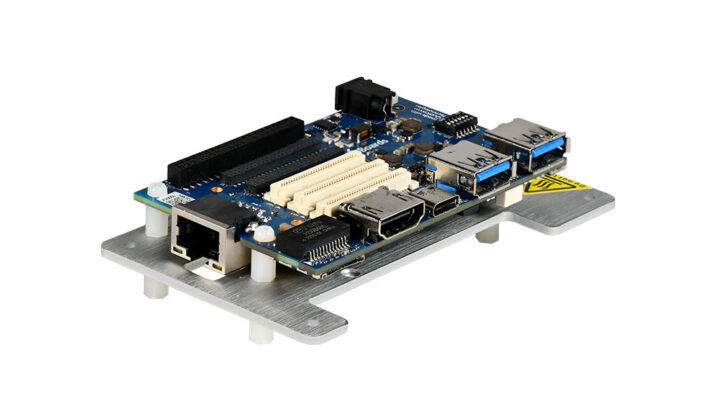
All kits are based on the Qualcomm Robotics RB1/RB2 Core Kit with the following (preliminary) specifications:
- System-on-module
- RB1 – Thundercomm TurboX C2210
- SoC – Qualcomm QRB2210
- CPU – Quad-core Cortex-A53 processor at up to 2.0 GHz
- GPU – Adreno 702 GPU at 845 MHz with support for OpenGL ES 3.1, Vulkan 1.1, OpenCL 2.0
- Hexagon QDSP6 v66 DSP
- 1080p 30 fps encode / 1080p 30fps decode
- System Memory – 1GB or 2GB LPDDR4
- Storage – 8GB or 16GB eMMC flash
- Wireless – WiFi 5 and Bluetooth 5.0
- GNSS – Glonass, BeiDou, Galileo, QZSS, SBAS, NavIC
- Dimensions – 35 x 34 x 2.9mm
- SoC – Qualcomm QRB2210
- RB2 – Thundercomm TurboX C4210
- SoC – Qualcomm QRB4210
- CPU – Octa-core Qualcomm Kryo 260 at up to 2.0 GHz (4x Cortex-A73 @ 2.0 GHz, 4x Cortex-A53 @ 1.8 GHz)
- GPU – Qualcomm Adreno 610 with OpenGL ES 3.1, Vulkan 1.1, OpenCL 2.0
- DSP – Qualcomm Hexagon 683
- VPU
- Decode: Up to 1080p60 8-bit H.264, 1080p60 8-bit HEVC (H.265), VP9
- Encode: Up to 1080p60 8-bit HEVC (H.265), 1080p60 8-bit H.264
- AI – Up to 1.7 TOPS
- System Memory – 2GB LPDDR4x
- Storage – 16GB eMMC flash
- Wireless – WiFi 5 and Bluetooth 5.0
- GNSS – Glonass, BeiDou, Galileo, QZSS, SBAS, NavIC
- Dimensions – 35 x 34 x 2.9mm
- SoC – Qualcomm QRB4210
- RB1 – Thundercomm TurboX C2210
- Storage – MicroSD card slot
- Video Output – HDMI port up to 4K resolutions
- Networking – Low-profile Gigabit Ethernet RJ45 port
- USB – 2x USB 3.0 ports, 1x USB Type-C port
- Sensor – IMU
- Expansion
- 40-pin 96boards Low Speed connector with 2.54mm pitch
- 2x 40-pin 96boards Low Speed connectors with 2.00 pitch
- 3x 60-pin 96boards High Speed connectors
- Debugging – Micro USB port for serial console
- Misc – Multiple DIP switches for configuration, power LED, digital microphone, on/off and volume buttons, 4-pin fan connector
- Power Supply – 12V DC via power barrel jack
- Dimensions – 85 x 54 mm (96Boards CE v2.0 form factor)
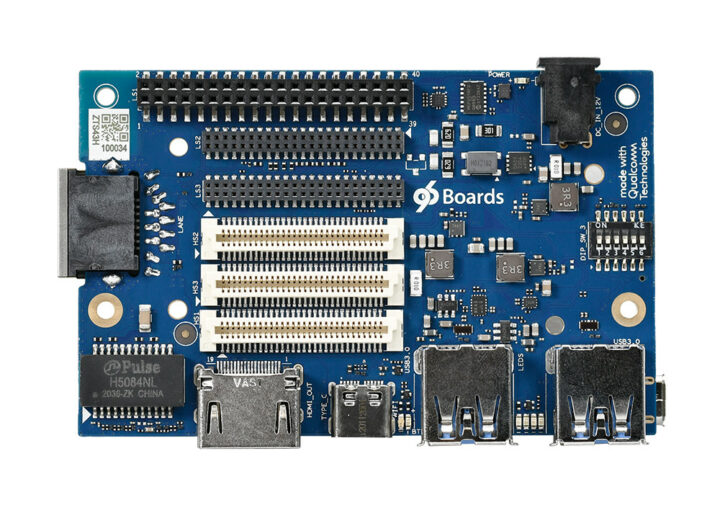
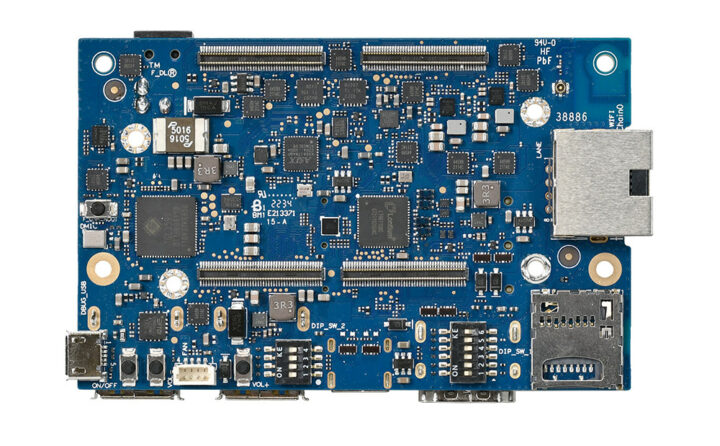 Apart from the SoM specifications, I had to “reverse-engineer” the specifications from the photos, something I might expect to do for an obscure Chinese board, but not necessarily for a Qualcomm development kit that was announced a week ago at Embedded World 2023.
Apart from the SoM specifications, I had to “reverse-engineer” the specifications from the photos, something I might expect to do for an obscure Chinese board, but not necessarily for a Qualcomm development kit that was announced a week ago at Embedded World 2023.
Qualcomm has a product page, but with limited details, albeit the block diagrams can help. Thundercomm usually provides documentation, but not for RB1/RB2 just yet, and you can check out the documents for the earlier RB6 devkit to have an idea of what you may get.
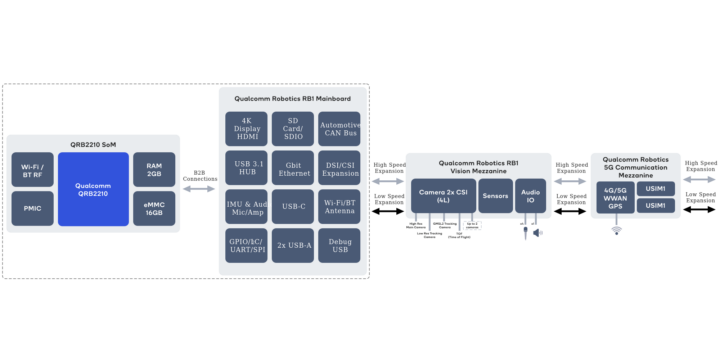
The Core Kit is probably limited under you add your own Mezzazine board(s), so Thundercomm also provides the Vision Kit that adds the Vision Mezzanine with two (GMSL) camera connectors and two cameras.
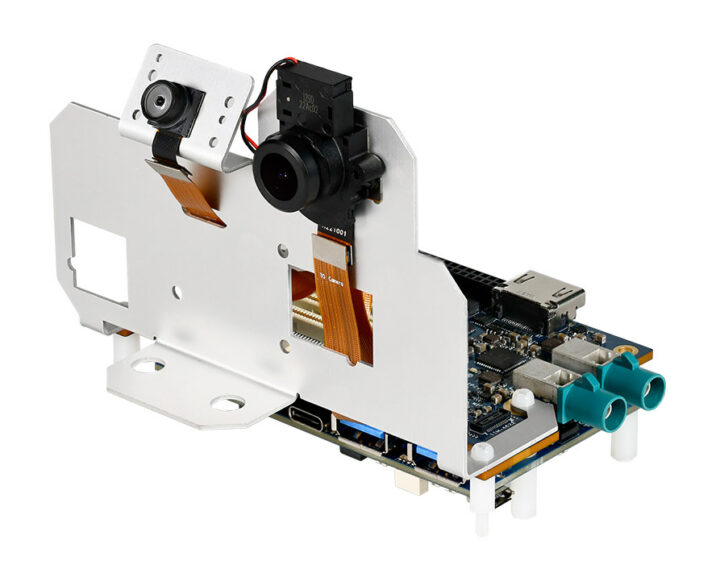
The RB1/RB2 Full Kit adds a smartphone-like display to the development kit.
Applications for the Robotics RB1 platform include service robots, dash cameras, Smart Display assistants, Smart gateway, and industrial handhelds, and the Robotics RB2 platform is also suitable for those as well as vacuum robots and E-scooters.
The Qualcomm Robotics RB1/RB2 development kits are available now at the following prices:
- Core Kit – RB1: $199, RB2: $249
- Vision Kit – RB1: $449, RB2: $499
- Full Kit – RB1: $499, RB2: $549
You may find additional details and purchase links on the respective product pages.
Thanks to TLS for the tip.

Jean-Luc started CNX Software in 2010 as a part-time endeavor, before quitting his job as a software engineering manager, and starting to write daily news, and reviews full time later in 2011.
Support CNX Software! Donate via cryptocurrencies, become a Patron on Patreon, or purchase goods on Amazon or Aliexpress


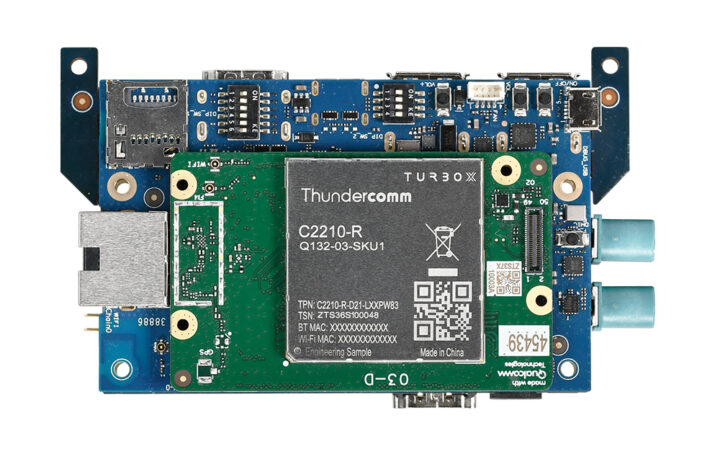
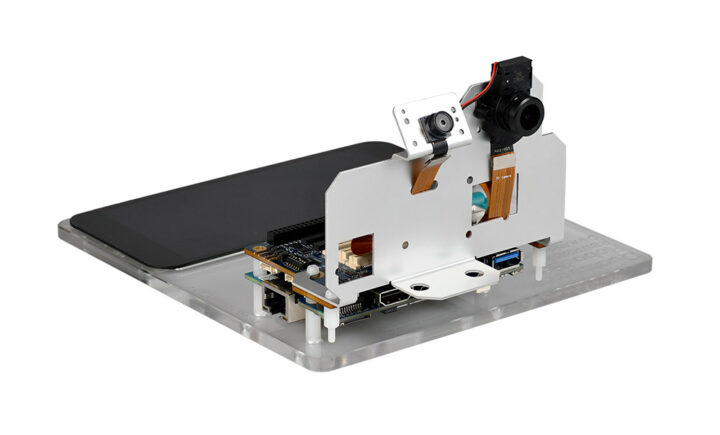



The QRB4210 from the rb2 appears to be the Snapdragon 662 (at least according to the specifications of what the 662 contains on wikipedia’s list of snapdragon processors).